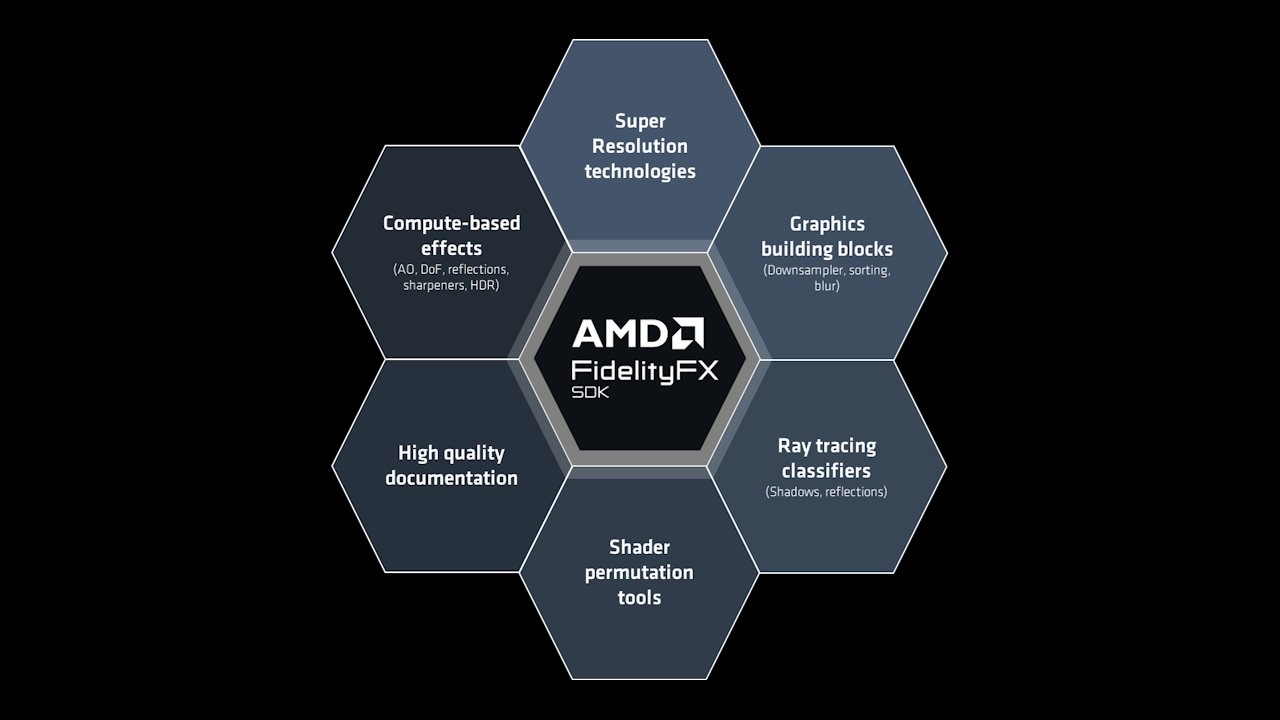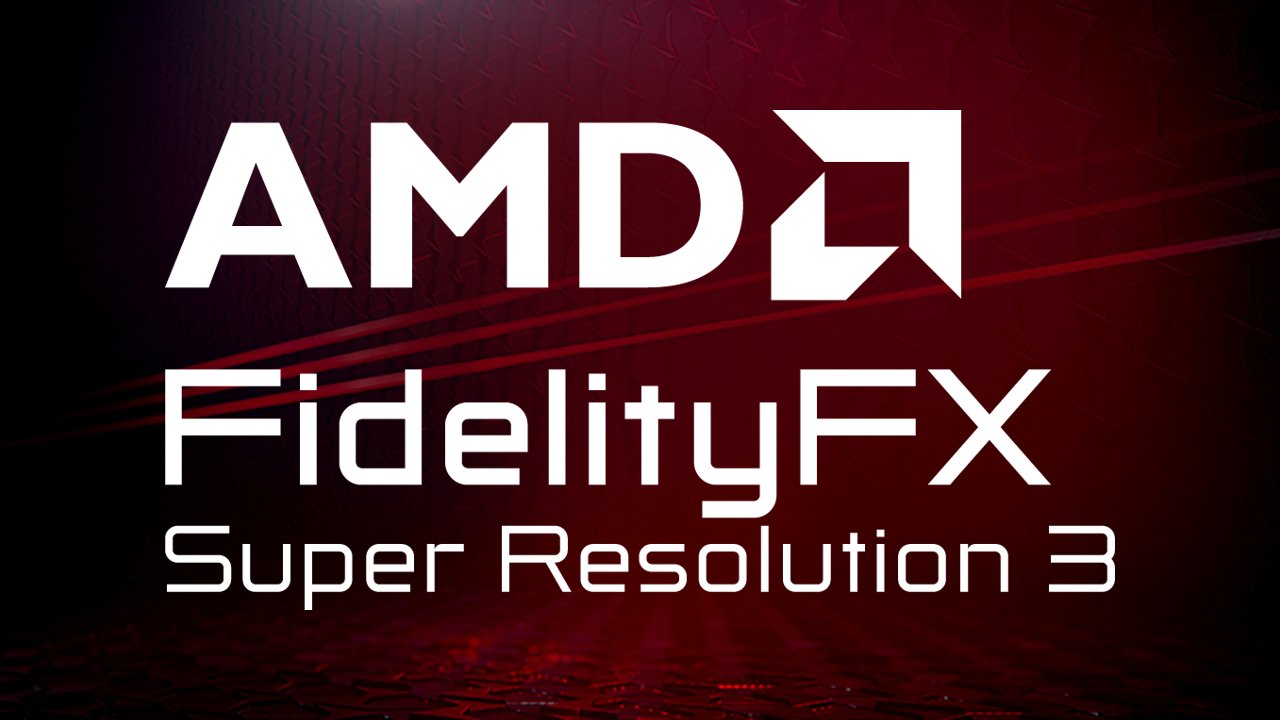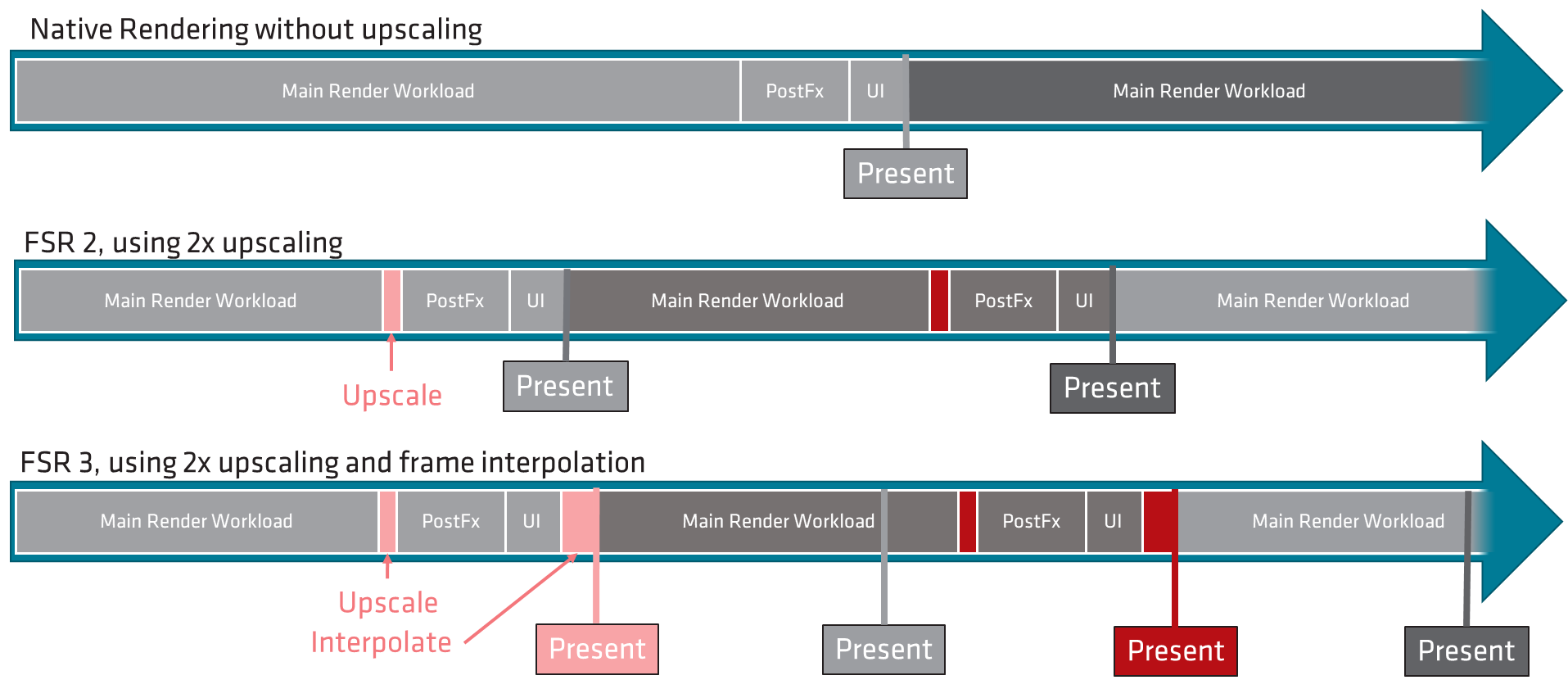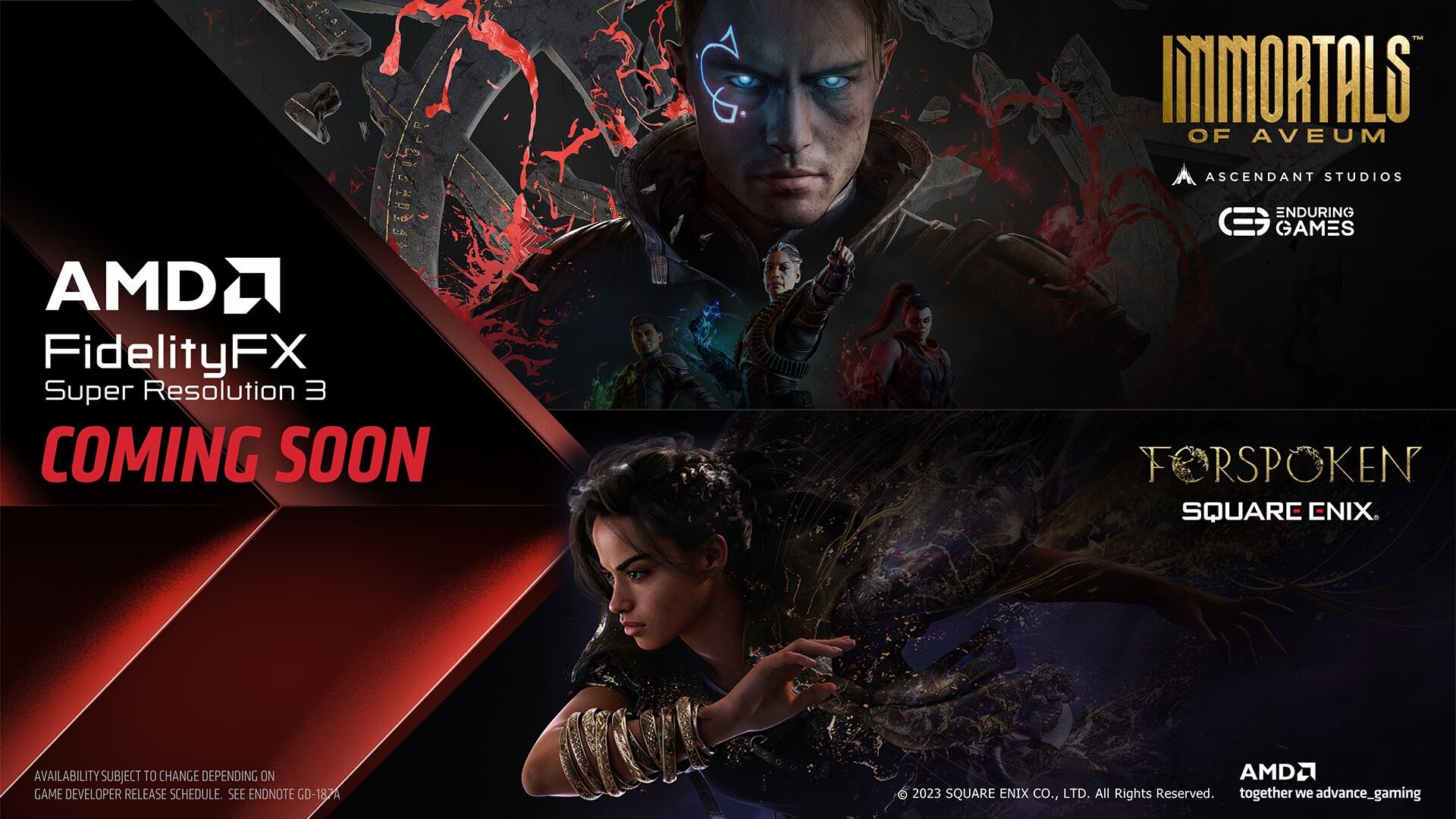
AMD FidelityFX™ SDK
The AMD FidelityFX SDK is our easy-to-integrate solution for developers looking to include FidelityFX features into their games.
GPUOpen has always been committed to open source and standards-based technologies, making us the natural home for game developers looking for AMD FidelityFX™ Super Resolution (FSR) technologies, including the upcoming AMD FSR 3.
If that’s you, you’ll need to wait a little longer before you can get hold of the source code or Unreal Engine 5 plugins for FSR 3. We’ll be sharing it here on GPUOpen in the near future, but following our reveal at gamescom 2023, we can share some exciting new updates about our latest super resolution technology!

AMD FidelityFX Super Resolution 3 uses a combination of super resolution temporal upscaling technology and frame generation to deliver a massive increase in framerates in supported games.
We first introduced FSR 3 to developers earlier this year during GDC 23. Our presentation on Temporal Upscaling: Past, Present, and Future [YouTube video, slides] revealed some early information on FSR 3, and the benefits and challenges during development.

To briefly recap, the FSR 3-related parts of the presentation covered:
AMD.com’s latest blog about AMD FSR 3 for gamer audiences was posted today, with lots of gaming-related details. The official line there on FSR 3’s new features is all about the addition of frame generation as you’d expect. In a nutshell, an enhanced version of AMD Fluid Motion Frames (AFMF) optical flow technology combined with temporal game data is being used to generate additional high-quality frames, for a higher perceived framerate by up to 21 in supported games.
This is a blog aimed at developers though, so let’s get stuck into some of the development details as well!
Since GDC 23, we’ve been hard at work improving FSR 3. Here’s what’s been happening:
We’re excited to introduce Native AA to FSR 3, which we know both devs and gamers have been asking for. Unlike our other modes, gamers can use FSR 3 without applying any upscaling, but they’ll still get the high-quality AA and sharpening from FSR. There is a modest performance cost when using this new mode.
Native AA can also be combined together with FSR 3 frame generation, providing a substantial performance boost3 .
AMD FSR 3 also includes the latest version of FSR 2, which has continued to be improved since launch, and has also been optimized to be fully integrated with the new frame generation technology.
Side benefit: if a game already implements FSR 2, it will be much easier to integrate FSR 3.
As with our other FSR technologies, you’ll find familiar upscaling quality modes such as “Quality”, “Balanced”, and “Performance” so gamers can configure the ratio to suit their preferences.
This really shouldn’t be news to you here on GPUOpen!
All our AMD FidelityFX technologies are included in the new AMD FidelityFX SDK we released in June, so we’re really excited that we will soon be adding FSR 3 to the FidelityFX SDK, alongside our existing FSR 1 and FSR 2 upscaling solutions.
In case you missed this news, the FidelityFX SDK makes it easier for you to integrate all our FidelityFX technologies (shaders and runtime code) into your DirectX®12 or Vulkan® applications without the hassle of complicated porting procedures.
Speaking of porting requirements, like earlier versions, AMD FSR 3 remains a cross-platform technology.
Though while FSR 3 will also work with a very broad range of hardware, we are still recommending to gamers that to experience an optimal and low-latency experience, they should always run at a minimum of 60 FPS before frame generation is applied. As hardware can vary, we suggest they should adjust other game graphics settings and upscaling quality to achieve this.
AMD FSR 3 is an open technology that does not require machine learning (ML) hardware, allowing it to be supported on a broad range of products and platforms, including consoles. When using FSR 3 with super resolution upscaling and frame generation we recommend the following hardware:
Supported and recommended hardware for using AMD FSR 3 with Upscaling and Frame Generation
| AMD | NVIDIA |
|---|---|
Supported: Recommended: | Supported: Recommended: |
(Note: we do not suggest using frame generation on products lower than our recommendations above. How frame generation performs will depend on the capabilities of your GPU and on older hardware you may not have an optimal experience and may see little to no improvement in performance.)
As AMD FSR 3 is an open technology, it will work on a broader range of hardware beyond what we recommend above. If just using super resolution upscaling WITHOUT frame generation, we recommend the following hardware:
Supported and recommended hardware for using AMD FSR 3 with Upscaling ONLY
| AMD | NVIDIA |
|---|---|
Supported: Recommended: | Supported: Recommended: |
We’re very excited that we’re now very close to seeing AMD FSR 3 in the first games. Support is expected via game updates in early Fall for Forspoken and Immortals of Aveum.

Take a first look at AMD FSR 3 in Forspoken by Square Enix by watching the video below: (opens in a new window)
So far, along with Unreal Engine (look out for our FSR 3 plug-in for UE5!) we have 15 game developers and publishers currently committed to supporting AMD FSR 3, with more expected to come on board in the future. If you don’t see your studio below yet, we hope you will be next!

Our earlier AMD FidelityFX Super Resolution technologies (AMD FSR 1 and FSR 2) are already in over 300 games, which is remarkable given FSR 1 only launched two years ago. This is not only a testament to its support across a broad range of products and platforms, including consoles, but also to its ease of integration. And if you do end up needing to read the… manual, our helpful documentation for FSR 1 and FSR 2 is there to back you up, and you can expect the same again from FSR 3.

We’re hard at work putting the finishing touches to our code before we’re ready to share it with the world in the near future.
Want to make sure you’re the first to hear when it’s ready? Then make sure to follow us on X (x-Twitter) @GPUOpen or Mastodon, add our RSS feed, or just keep popping back here.
And if you want to read more today about FSR 3, head on over to the amd.com blog aimed at gamers, where you can hear more about performance in Forspoken, and more!
11 BIT STUDIOS®, FROSTPUNK 2® are registered trademarks of 11 BIT STUDIOS S.A. © 11 BIT STUDIOS S.A. All other marks and trademarks are the property of their respective owners. All rights reserved.
Ascendant Studios logo © 2022 Ascendant Studios, LLC.
Ubisoft and the Ubisoft logo are registered or unregistered trademarks of Ubisoft Entertainment in the U.S. and/or other countries.
Black Myth: Wukong copyright © Game Science Interactive Technology Co., Ltd. All Rights Reserved
CD PROJEKT®, CD PROJEKT RED®, the CD PROJEKT RED® logo, Cyberpunk®, Cyberpunk 2077®, and the Cyberpunk 2077® logo are registered trademarks of CD PROJEKT S.A. © 2020 CD PROJEKT S.A. All rights reserved.
Crimson Desert copyright © Pearl Abyss Corp. All Rights Reserved
Enduring Games © copyright 2023 Enduring Games® Inc.
FORSPOKEN © 2023 SQUARE ENIX CO., LTD. All Rights Reserved.
Immortals of Aveum © 2023 Electronic Arts Inc.
Like a Dragon: Infinite Wealth © SEGA. All rights reserved. SEGA is registered in the U.S. Patent and Trademark Office. SEGA, the SEGA logo, Yakuza and LIKE A DRAGON are registered trademarks or trademarks of SEGA CORPORATION or its affiliates. All other trademarks, logos and copyrights are property of their respective owners.
Massive Entertainment – a Ubisoft studio. © 2023 Ubisoft Entertainment. All Rights Reserved. Ubisoft, Massive and their logos are trademarks of Ubisoft.
Reflector logo © 2023 Reflector Entertainment Ltd. All rights reserved. © Bandai Namco Entertainment America Inc.
Squad © 2023 Offworld Industries Ltd. Offworld Industries® and the Offworld logo are both registered Canadian trademarks.
SQUARE ENIX and the SQUARE ENIX logo are registered trademarks or trademarks of Square Enix Holdings Co., Ltd.
The Alters © 2022 11 BIT STUDIOS S.A. All rights reserved.
Unreal Engine © 2004-2023, Epic Games, Inc. All rights reserved. Unreal and its logo are Epic’s trademarks or registered trademarks in the US and elsewhere.
Focus Entertainment, Focus Home Interactive and their logos are trademarks or registered trademarks of Focus Home Interactive.
Saber Interactive and its logos are trademarks or registered trademarks of Saber Interactive. All rights reserved to their respective owners.
Further game attributions @ AMD
AMD Fluid Motion Frames interpolation technology when used with AMD FidelityFX Super Resolution (FSR) 3 inserts 1 frame between existing ones which can therefore enable up to 2x the framerate in supported games. GD-231 ↩
AMD Radeon™ Anti-Lag+ works on the AMD Radeon™️ RX 7000 Series GPUs and newer or the AMD Ryzen™ 7040 Series APUs with integrated AMD RDNA™ 3 graphics and newer. AMD Radeon Anti-Lag+ further reduces latency within specific titles where AMD has partnered with game developers. GD-227. ↩
Testing by AMD as of August 21, 2023, on an AMD Radeon RX 7900 XTX graphics card AMD Software: Adrenalin Edition 23.7.2 driver, AMD Smart Access Memory technology, and AMD FidelityFX Super Resolution 3 technology with “Native AA” mode and frame generation enabled versus AMD FSR 3 OFF, on a test system configured with an AMD Ryzen 9 5950X CPU, AMD Radeon RX 7900 XTX graphics, 32GB DDR4-3800 RAM, ASUS ROG Crosshair VIII Hero (Wi-Fi) motherboard, and Windows 10 Pro 2022 Update, using the Forspoken built-in benchmark at 3840 x 2160, “Ultra-High” graphics preset, and DirectX 12. Performance is dependent on the AMD FSR 3 quality mode selected. AMD FSR 3 requires developer integration and is available in select games. Laptop manufacturers may vary configurations, yielding different results. RS-593. ↩